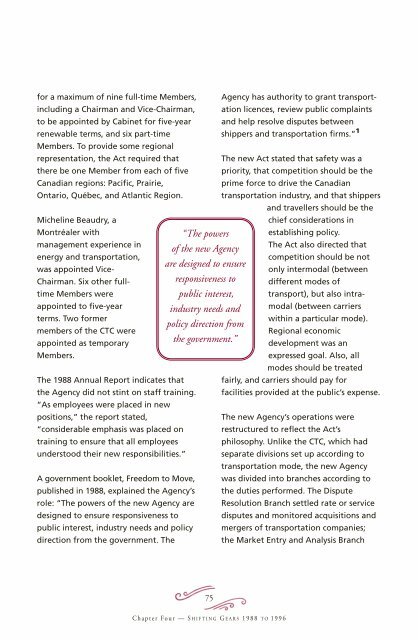TT4-2-2003E.pdf - Office des transports du Canada
TT4-2-2003E.pdf - Office des transports du Canada
TT4-2-2003E.pdf - Office des transports du Canada
Create successful ePaper yourself
Turn your PDF publications into a flip-book with our unique Google optimized e-Paper software.
for a maximum of nine full-time Members,including a Chairman and Vice-Chairman,to be appointed by Cabinet for five-yearrenewable terms, and six part-timeMembers. To provide some regionalrepresentation, the Act required thatthere be one Member from each of fiveCanadian regions: Pacific, Prairie,Ontario, Québec, and Atlantic Region.Micheline Beaudry, aMontréaler withmanagement experience inenergy and transportation,was appointed Vice-Chairman. Six other fulltimeMembers wereappointed to five-yearterms. Two formermembers of the CTC wereappointed as temporaryMembers.The 1988 Annual Report indicates thatthe Agency did not stint on staff training.“As employees were placed in newpositions,” the report stated,“considerable emphasis was placed ontraining to ensure that all employeesunderstood their new responsibilities.”A government booklet, Freedom to Move,published in 1988, explained the Agency’srole: “The powers of the new Agency are<strong>des</strong>igned to ensure responsiveness topublic interest, in<strong>du</strong>stry needs and policydirection from the government. The“The powersof the new Agencyare <strong>des</strong>igned to ensureresponsiveness topublic interest,in<strong>du</strong>stry needs andpolicy direction fromthe government.”Agency has authority to grant transportationlicences, review public complaintsand help resolve disputes betweenshippers and transportation firms.” 1The new Act stated that safety was apriority, that competition should be theprime force to drive the Canadiantransportation in<strong>du</strong>stry, and that shippersand travellers should be thechief considerations inestablishing policy.The Act also directed thatcompetition should be notonly intermodal (betweendifferent mo<strong>des</strong> oftransport), but also intramodal(between carrierswithin a particular mode).Regional economicdevelopment was anexpressed goal. Also, allmo<strong>des</strong> should be treatedfairly, and carriers should pay forfacilities provided at the public’s expense.The new Agency’s operations wererestructured to reflect the Act’sphilosophy. Unlike the CTC, which hadseparate divisions set up according totransportation mode, the new Agencywas divided into branches according tothe <strong>du</strong>ties performed. The DisputeResolution Branch settled rate or servicedisputes and monitored acquisitions andmergers of transportation companies;the Market Entry and Analysis Branch75Chapter Four — SHIFTING G EARS 1988 TO 1996





